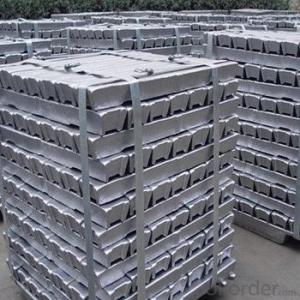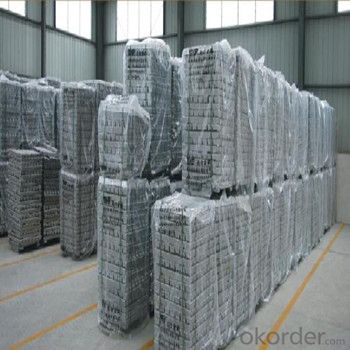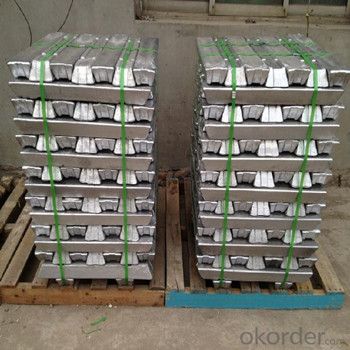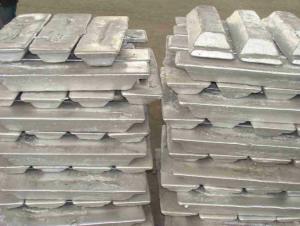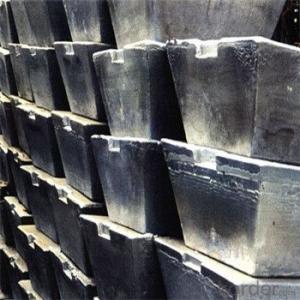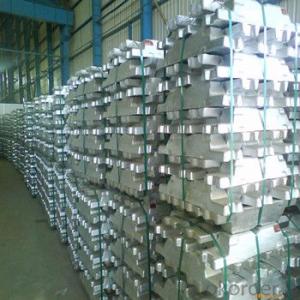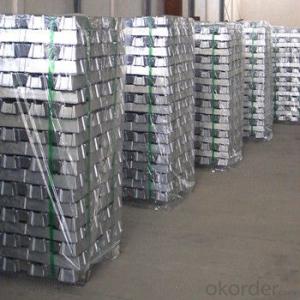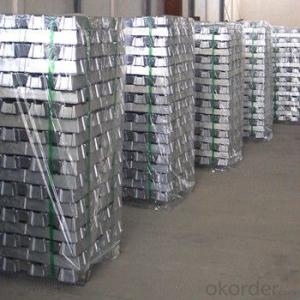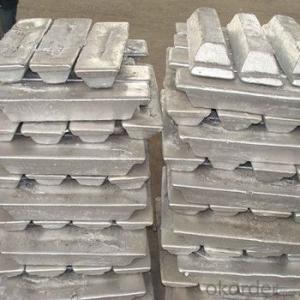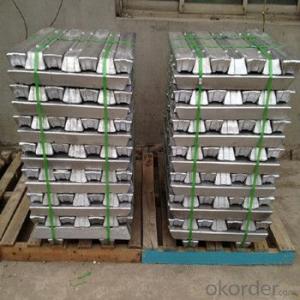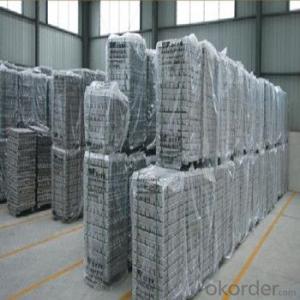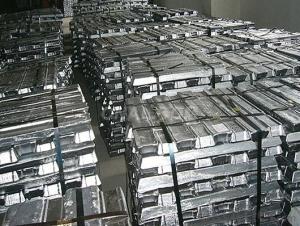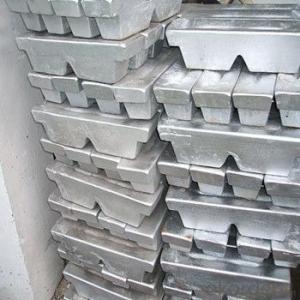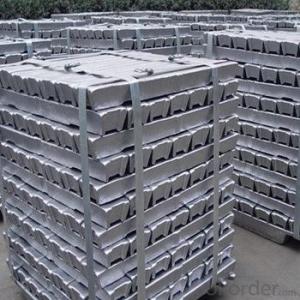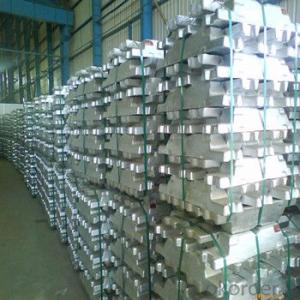Aluminum Pig/Ingot With High Quality And Hight Purity
- Loading Port:
- China main port
- Payment Terms:
- TT OR LC
- Min Order Qty:
- 1000 m.t.
- Supply Capability:
- 100000 m.t./month
OKorder Service Pledge
OKorder Financial Service
You Might Also Like
Pure Aluminum Pig/Ingot Used for Industry
1.Structure of Aluminum Pig/Ingot
A material that has been cast into a shape in order to be transported and processed easier than in an unprocessed form. An ingot is typically rectangular in shape, which allows it to be stacked. Ingots are most commonly associated with metals, with ingots of gold held in the vaults of banks and brokerages being popular images.
Aluminum Ingot is with the AL as the main chemical composition.Aluminum Ingot is used for industry,such as automobile,pinning and weaving,electron broadly and so on. Aluminum Ingot has the following advantages: easy control and operation, fast melting.
2.Main Features of the Aluminum Pig/Ingot
•High Purity
•Easy control and operation
•High strength
•Fast melting
•Competitive price
•Best Service
3.Aluminum Pig/Ingot Images
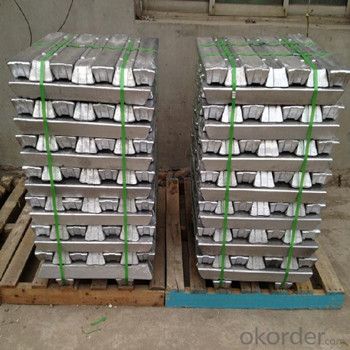
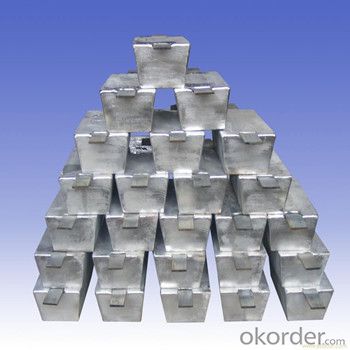
4.Aluminum Pig/Ingot Specification
Grade | Chemical Composition % | |||||||||
Al≥ | impurities ≤ | |||||||||
Si | Fe | Cu | Ga | Mg | Zn | Mn | others | Sum | ||
Al99.9 | 99.90 | 0.50 | 0.07 | 0.005 | 0.02 | 0.01 | 0.025 | - | 0.010 | 0.10 |
Al99.85 | 99.85 | 0.80 | 0.12 | 0.005 | 0.03 | 0.02 | 0.030 | - | 0.015 | 0.15 |
Al99.7 | 99.70 | 0.10 | 0.20 | 0.010 | 0.03 | 0.02 | 0.030 | - | 0.030 | 0.30 |
Al99.6 | 99.60 | 0.16 | 0.25 | 0.010 | 0.03 | 0.03 | 0.030 | - | 0.030 | 0.40 |
Al99.5 | 99.50 | 0.22 | 0.30 | 0.020 | 0.03 | 0.05 | 0.050 | - | 0.030 | 0.50 |
Al99.00 | 99.00 | 0.42 | 0.50 | 0.020 | 0.03 | 0.05 | 0.050 | - | 0.050 | 1.00 |
5.FAQ of Aluminum Pig/Ingot
We have organized several common questions for our clients,may help you sincerely:
①How about your company?
A reliable manufacturer & supplier of Aluminum Pig/Ingot,with many years’ experience in producing Aluminum Pig/Ingot.The items have beedn exported around the world,and have been acceptable among the customers,and have gotten the good reputation already.No matter from the quality,price and service,can be guaranteed for the cusgtomers.High purity and diffent grade are available.
②How to guarantee the quality of the products?
We have established the international advanced quality management system,every link from raw material to final product we have strict quality test;We resolutely put an end to unqualified products flowing into the market. At the same time, we will provide necessary follow-up service assurance.
③How long can we receive the product after purchase?
In the purchase of product within three wo We have organized several common questions for our clients,may help you sincerely:
- Q: What are the different grades of aluminum ingots?
- Aluminum ingots come in various grades, each possessing distinct properties and applications. The commonly known grades comprise: 1. Pure Aluminum (99%+): This grade represents the elemental form of aluminum and possesses remarkable malleability, lightness, and resistance to corrosion. It finds extensive utilization in scenarios necessitating high electrical conductivity, such as electrical wiring and transmission lines. 2. Aluminum Alloys: These grades consist of aluminum blended with other elements like copper, magnesium, silicon, or zinc, to enhance specific characteristics. For instance, aluminum alloys containing copper are renowned for their exceptional strength and resistance to corrosion, rendering them ideal for structural components within the aerospace and automotive industries. 3. Cast Aluminum: This grade is produced through the casting process and is commonly employed in the production of engine parts, automotive wheels, and other demanding applications that prioritize strength and durability. 4. Wrought Aluminum: Wrought aluminum ingots experience a shaping process, such as rolling or extrusion, to create tailored forms like sheets, plates, or bars. This grade is frequently utilized in the construction sector for structural elements like beams, columns, and facade systems. 5. High-Strength Aluminum: These grades are engineered to possess superior strength while retaining good formability. They find extensive use in industries requiring lightweight, yet sturdy materials, such as aerospace, military, or sporting goods manufacturing. It's worth noting that these grades can be further categorized into specific alloys, each possessing unique characteristics and applications. The selection of an aluminum grade depends on the intended usage, desired properties, and manufacturing requirements of the final product.
- Q: What are the different welding methods for aluminum ingots?
- There are several different welding methods that can be used for aluminum ingots, each with its own advantages and applications. Some of the most common welding methods for aluminum ingots include: 1. Tungsten Inert Gas (TIG) Welding: TIG welding is a popular choice for welding aluminum ingots. It uses a non-consumable tungsten electrode to create the arc and a shielding gas to protect the weld from atmospheric contamination. TIG welding provides high-quality, precise welds with excellent control over the heat input. It is commonly used in industries like aerospace and automotive, where high-quality welds are crucial. 2. Metal Inert Gas (MIG) Welding: MIG welding is another widely used welding method for aluminum ingots. It uses a consumable wire electrode and a shielding gas to protect the weld zone. MIG welding is relatively faster and easier to learn compared to TIG welding, making it suitable for applications that require high productivity and volume, such as fabrication and manufacturing. However, it may not provide the same level of precision as TIG welding. 3. Gas Metal Arc Welding (GMAW): GMAW, also known as MIG welding, is commonly used for aluminum ingots. It utilizes a continuous wire electrode and a shielding gas to protect the weld from atmospheric contamination. GMAW offers high welding speeds and is often used in industries like automotive and construction, where efficiency and productivity are important. 4. Plasma Arc Welding (PAW): PAW is a precise and versatile welding method that can also be used for aluminum ingots. It uses a focused plasma arc to create the weld and a shielding gas for protection. PAW can provide high-quality welds with minimal heat input, making it suitable for thin aluminum sheets or delicate applications. 5. Friction Stir Welding (FSW): FSW is a solid-state welding process that can be used for aluminum ingots. It uses a rotating tool to generate friction and heat, which softens the material and allows it to be joined. FSW is particularly useful for joining thick or complex aluminum structures, as it reduces the risk of distortion and produces strong, defect-free welds. Overall, the choice of welding method for aluminum ingots depends on factors such as the desired weld quality, productivity requirements, material thickness, and specific application. Each method has its own advantages and limitations, and it is important to select the most appropriate method based on the specific project requirements.
- Q: What are the advantages of using aluminum ingots in the production of medical devices?
- Using aluminum ingots in the production of medical devices offers several benefits. Firstly, aluminum is a lightweight metal, making it ideal for portable and easy-to-handle medical devices. It reduces device weight, enhancing patient comfort and healthcare professionals' ease of use. Secondly, aluminum possesses exceptional corrosion resistance properties, crucial for medical devices that come into contact with bodily fluids and chemicals. By utilizing aluminum ingots, manufacturers ensure device durability and reliability by preventing corrosion or degradation over time. Moreover, aluminum is highly malleable, allowing for intricate design and shaping. This enables the production of complex medical devices with precise specifications, ensuring a better fit and improved functionality for patients. Furthermore, aluminum is non-toxic and biocompatible, making it safe for direct contact with human tissues. It can be safely used in implants, surgical instruments, and prosthetics, minimizing the risk of adverse reactions or complications for patients. Lastly, aluminum ingots are cost-effective compared to other commonly used metals in medical device production. The abundance of aluminum ore and its relatively low extraction cost make it a more affordable option for manufacturers. This cost-effectiveness can result in more accessible medical devices, benefiting patients and healthcare systems worldwide. In conclusion, the advantages of using aluminum ingots in medical device production encompass their lightweight nature, excellent corrosion resistance, malleability, biocompatibility, and cost-effectiveness. These properties make aluminum a suitable choice for creating high-quality, durable, and safe medical devices.
- Q: How are aluminum ingots stored and transported?
- Aluminum ingots are typically stored and transported in various ways. They are commonly stored in warehouses or outdoor yards, where they are stacked on pallets or placed in racks. To ensure their safety, ingots are often stored in a dry and ventilated area to prevent corrosion and maintain their quality. When it comes to transportation, aluminum ingots are commonly moved using different methods. They can be loaded onto trucks, railcars, or shipping containers for long-distance transportation. To secure the ingots during transit, they may be wrapped in protective packaging materials or placed in crates or bins. Additionally, specialized equipment like forklifts or cranes are used to handle and move the ingots safely during loading and unloading operations. Overall, the storage and transportation methods for aluminum ingots prioritize their protection and efficient movement to their intended destinations.
- Q: How is the price of aluminum ingots determined?
- The price of aluminum ingots is determined by various factors in the global market. Supply and demand dynamics play a crucial role in shaping the price of aluminum ingots. The demand for aluminum, which is used in a wide range of industries such as automotive, construction, aerospace, and packaging, greatly influences its price. Additionally, the availability of aluminum ore, known as bauxite, and the cost of extracting and refining it into aluminum ingots impact the price. Any changes in the cost of production, such as energy prices or labor costs, can influence the final price of aluminum ingots. Market conditions and economic factors also come into play. In times of economic growth, the demand for aluminum tends to increase, resulting in higher prices. Conversely, during periods of economic downturn, the demand may decrease, leading to lower prices. Furthermore, the global trade environment, including tariffs and import/export regulations, can affect the price of aluminum ingots. Government policies, such as subsidies or taxes on aluminum production, can also impact the final price. Lastly, the influence of speculators and investors in the commodities market can cause short-term fluctuations in aluminum ingot prices. Speculative trading, based on anticipated changes in supply and demand or geopolitical events, can temporarily drive prices up or down. Considering these factors, the price of aluminum ingots is determined through a complex interplay of supply, demand, production costs, market conditions, trade policies, and speculative trading.
- Q: How much does it cost to process the aluminum ingots into T5-6063 models? Now, what about costing the aluminum ingot or the aluminum bar?
- T6 is artificially aged by solid solution heat treatmentIt is suitable for the products which are treated by solid solution heat treatment, no longer cold processing (can be straightened and leveling, but does not affect the mechanical performance limit)
- Q: How are aluminum ingots used in the production of bicycles?
- The primary role of aluminum ingots in bicycle production is to serve as the main material for manufacturing bicycle frames. Aluminum, being a lightweight and durable metal, is an ideal choice for crafting frames that are both strong and lightweight. The process of producing bicycle frames involves first melting down aluminum ingots and then pouring the molten aluminum into molds to achieve the desired frame shape. After allowing the molten aluminum to cool and solidify, a solid ingot in the shape of the frame is formed. To further shape the aluminum ingots into tubes or other desired forms, various techniques such as extrusion or hydroforming are employed. These shaped tubes are then cut, welded, and joined together to create the overall frame structure of the bicycle. Aluminum ingots are preferred in bicycle manufacturing due to their exceptional strength-to-weight ratio. This characteristic allows for the creation of bicycles that are lighter in weight, making them easier to handle and maneuver, while still maintaining the necessary strength and rigidity for support. Moreover, aluminum ingots offer excellent resistance to corrosion, ensuring that the bicycle frames can endure harsh weather conditions and have a longer lifespan. This corrosion resistance is particularly significant for bicycles since they are frequently exposed to outdoor elements. Additionally, the use of aluminum ingots enables manufacturers to design frames with intricate and unique shapes, providing opportunities for customization and innovation in bicycle design. In conclusion, aluminum ingots are essential in bicycle production as they contribute to the creation of frames that are lightweight, durable, and resistant to corrosion. Their versatility and strength make them the preferred choice for manufacturers, ultimately enhancing the overall quality and performance of bicycles.
- Q: What are the different recycling methods for aluminum ingots?
- Aluminum ingots can be recycled through several methods, each with their own advantages and applications. One commonly used method is mechanical recycling, also known as shredding and melting. This process involves shredding the aluminum ingots into small pieces and then melting them in a furnace. The molten aluminum is then cast into new ingots or other forms for reuse. Mechanical recycling is highly efficient and can be applied to a wide range of aluminum products, including cans, automotive parts, and building materials. Another approach is smelting, which utilizes a high-temperature furnace to separate aluminum from other materials. The aluminum is melted and refined to eliminate impurities before being cast into ingots. Smelting is often employed for recycling aluminum from industrial waste, such as scrap metal or manufacturing byproducts. Chemical recycling is another method that involves breaking down aluminum into its basic components using chemical reactions. This technique is particularly useful for recycling aluminum from complex products, such as electronic waste or composite materials. The broken-down aluminum can then be used to produce new ingots or other aluminum products. Lastly, electrolysis is a method that employs an electric current to separate aluminum from its oxide form. Although this process is energy-intensive, it can be highly efficient in recycling aluminum from specific sources, such as aluminum dross or smelter slag. Electrolysis is commonly utilized in the aluminum industry to create high-quality ingots with specific characteristics. In conclusion, these various recycling methods for aluminum ingots offer multiple benefits, including reducing the demand for new aluminum, conserving energy, and minimizing environmental impact. By selecting the appropriate recycling method based on the type of aluminum waste, we can ensure a more sustainable and circular economy for this valuable resource.
- Q: Who knows, general aluminium ingot has those specifications?
- The aluminum ingot is divided into three kinds: aluminium ingots, high-purity aluminium ingots and aluminium alloy ingots according to different components. They can be divided into strips, round ingots, plate ingots, T ingots and so on according to shape and size.
- Q: What is the purity level of aluminum in an ingot?
- The purity level of aluminum in an ingot can vary depending on the specific manufacturing process and desired application. However, commonly produced aluminum ingots have a purity level of around 99.5% to 99.9%, which means they contain very minimal impurities.
Send your message to us
Aluminum Pig/Ingot With High Quality And Hight Purity
- Loading Port:
- China main port
- Payment Terms:
- TT OR LC
- Min Order Qty:
- 1000 m.t.
- Supply Capability:
- 100000 m.t./month
OKorder Service Pledge
OKorder Financial Service
Similar products
Hot products
Hot Searches
Related keywords
